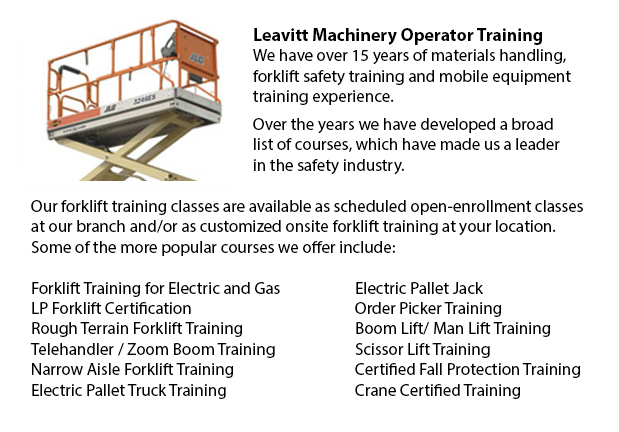
Scissor Lift Certification Richmond Hill - Scissor lift platforms are utilized at work sites in order to allow tradespeople - like for example welders, masons and iron workers - to reach their work. Operating a scissor lift platform is usually secondary to their trade. Hence, it is essential that all platform operators be trained well and certified. Lift manufacturers, regulators and industry all work together in order to make certain that operators are trained in the safe utilization of work platforms.
Work platforms are also known as manlifts or AWPs. These machinery are stable and simple to operate, even if there is always some risk since they lift people to heights. The following are some important safety issues common to AWPs:
There is a minimum safe approach distance (MSAD) for all platforms in order to protect from accidental power discharge because of proximity to wires and power lines. Voltage could arc across the air and cause injury to workers on a work platform if MSAD is not observed.
In order to ensure maximum steadiness, care must be taken when lowering the work platform. Moving the load towards the turntable, the boom must be retracted. This would help maintain stability during lowering of the platform.
Regulations do not mandate those working on a scissor lift to tie off. However, personnel may be needed to tie off if required by employer rules, job-specific risk assessments or local regulations. The manufacturer-provided anchorage is the only safe anchorage wherein lanyard and harness combinations must be attached.
Observe the maximum slope rating and do not go beyond it. A grade could be measured by laying a straight edge or board on the slope. Next, a carpenter's level can be placed on the straight edge and raised until the end is level. By measuring the distance to the ground and dividing the rise by the length of the straight edge, then multiplying by 100, the per cent slope could be determined.
A typical walk-around check has to be performed to determine if the unit is mechanically safe. A location assessment determines if the work place is safe. This is essential especially on changing construction locations because of the possibility of obstacles, contact with power lines and unimproved surfaces. A function test should be done. If the unit is used safely and properly and correct shutdown procedures are followed, the chances of incident are really reduced.
-
Narrow Aisle Forklift / Order Picker Training / Electric Pallet Jack / Electric Pallet Truck Training in Richmond Hill
A pallet jack is a model of equipment specialized in the transporting of pallets of many dimensions and weights. They might be utilized as an appendage for lift trucks, cranes and other types of heavy machinery or be used on their own. Pallet jacks a... More -
Heavy Equipment Operator Certification Richmond Hill
Heavy Equipment Operator Certification Richmond Hill - The heavy equipment operator is a person who manipulates the controls and drives various kinds of big machinery. Heavy machinery is most frequently used on construction sites in order to deliver... More -
Loader Training Richmond Hill
Loader Training Richmond Hill - Why You Must Finish A Loader Training Course - Individuals wanting work in businesses that use lift trucks must undergo a Loader Training program prior to becoming a certified operator of a lift truck. There are lots o... More -
Manlift Training Richmond Hill
Manlift Training Richmond Hill - Various manlift training programs consist of the review and content of manlift devices. An important part of the course is the practicum where students show their knowledge and practical ability to safely operate a ma... More -
Fall Protection Training in Richmond Hill
There are many injuries at work associated to falling and a lot of fall-related deaths reported every year. Most of these instances could have been prevented with better training, better measures in place, and by correctly equipping personnel before... More -
Wheel Loader Training Richmond Hill
Wheel Loader Training Richmond Hill - Commonly, the various kinds of heavy equipment training are classed into 2 categories of machinery: those which have rubber tires and tracked vehicles. Tracked vehicles consist of items like cranes, bulldozers an... More -
Forklift Certification Schools Richmond Hill
Forklift Certification Schools Richmond Hill - Forklift Certification is mandatory in North America. Hence, forklift training programs are important both for companies and for people seeking jobs in industries as forklift operators. Forklift training... More -
Heavy Equipment Certification Richmond Hill
Heavy Equipment Certification Richmond Hill - Big pieces of machines and heavy-duty vehicles are often called heavy equipment. This broad term includes utility vehicles from agricultural and forestry implements to civil engineering vehicles, construc... More

Forklift Training Richmond Hill
TOLL FREE: 1-888-254-6157
Richmond Hill, Ontario
forklifttrainingrichmondhill.com
Email Us
About Us


